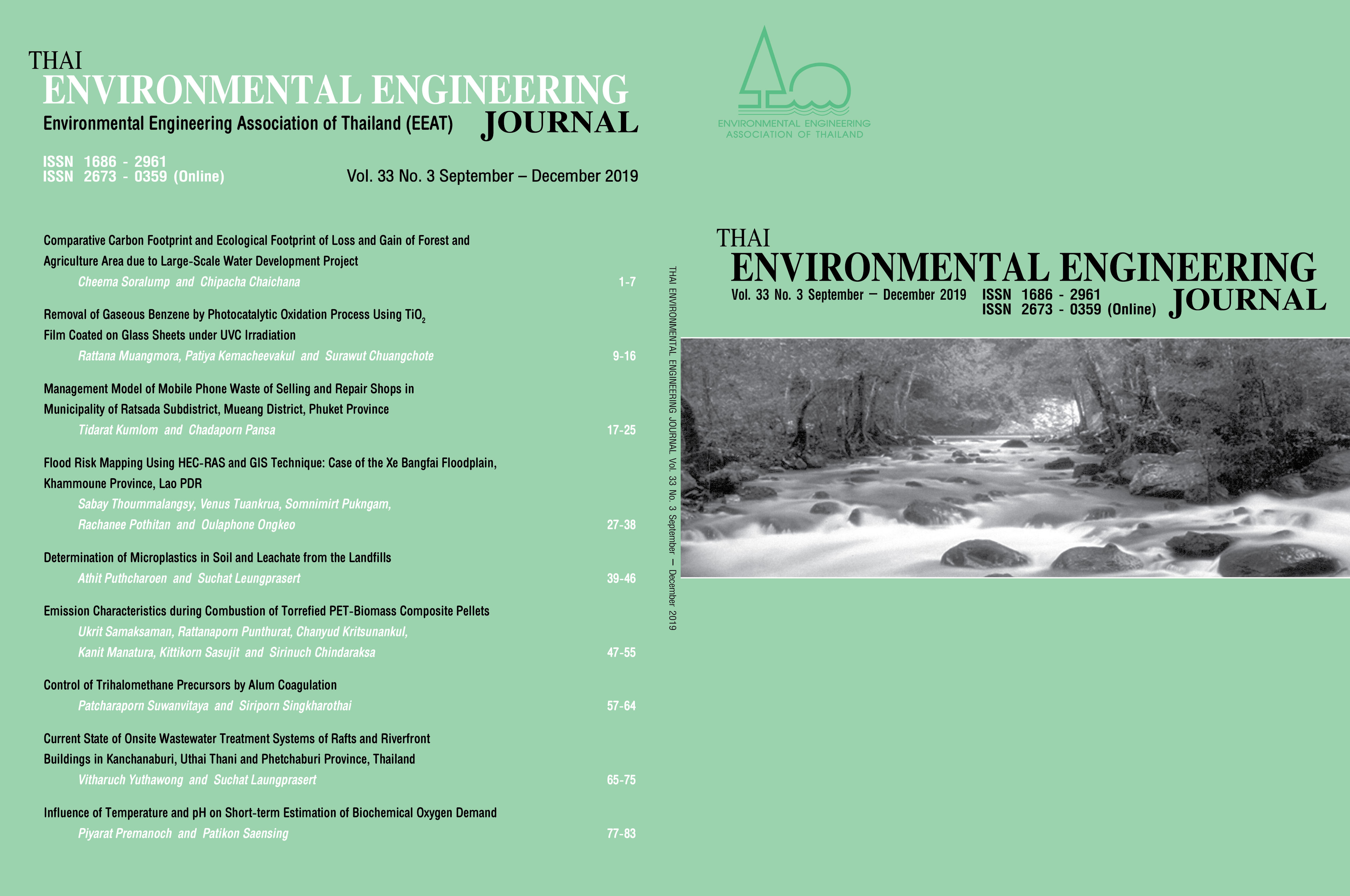Current state of onsite wastewater treatment systems of rafts and riverfront buildings in Kanchanaburi, Uthai Thani and Phetchaburi Province, Thailand
Main Article Content
Abstract
Deterioration of water quality in rivers is quite a concern in Thailand especially in the provinces where there is high intensity of river-related tourism industry. In such provinces, rafts and riverfront buildings, serving as tourism services (i.e. restaurants, hotels and water activities), generate and directly discharge partially or even untreated wastewater into rivers causing damage to the waterbodies. Although most of the buildings have installed onsite wastewater treatment systems (OWWTs), they are not capable of providing effluent with good water quality. Where OWWTs are not applicable, especially on rafts, wastewater is directly discharged into the water bodies. Current state of OWWTs of the rafts and riverfront buildings is critical in order to cope with the deteriorated water quality of the rivers. In this study, we explored types and treatment efficiencies of OWWTs in three provinces in Thailand including Phetchaburi, Kanchanaburi and Uthai Thani Province. The investigation indicated that the types of OWWTs were traditional cesspools and commercial septic tanks whose effluent quality was not suitable for direct discharge. Wastewater management options were recommended for the rafts and riverfront buildings.
Article Details
References
[2] Tsuzuki, Y., Koottatep, T., Wattanachira, S., Sarathai, Y. and Wongburana, C. 2009. On-site treatment systems in the wastewater treatment plants (WWTPs) service areas in Thailand: Scenario based pollutant loads estimation. Journal of global environment engineering. 14 57-65.
[3] Koottatep, T., Surinkul, N., Paochaiyangyuen, R., Suebsao, W., Sherpa, M., Liangwannaphorn, C. and Panuwatvanich, A. Assessment of faecal sludge rheological properties. 2012. -Report-
[4] Simakhajornboon, P. 2018. The managing guideline of Tambon Bangtaboon Municipality area as a slow tourism destination. Veridian E-journal, Silpakorn University. 1 (January-April 2018):
[5] Meier, P. Semi- and decentralized solutions for the treatment of domestic wastewater and wastewater of a marketplace in Chiang Mai (Thailand). 2016. Available on https://www.unescap.org/sites/default/files/Thailand_Chiang%20Mai-Final%20Study%20on%20Muang%20Mai%20Market.pdf. Retrieve on May 2019.
[6] Boontanon, S. K. and Buathong, T. 2013. On-site management for domestic wastewater in Thailand. Policy Brief Series 3.
[7] Maine Center for Desease Control and Prevention. Microbiology of Septic Systems. 2013. Available on https://www.maine.gov/dhhs/mecdc/environmental-health/plumb/documents/training/2013/Microbiology-of-Septic-Systems.pdf. Retrieve on May 2019.
[8] Lapointe, B. E. and Clark, M. W. 1992. Nutrient inputs from the watershed and coastal eutrophication in the Florida Keys. Estuaries. 15 (4): 465-476.
[9] Gill, L., O’Flaherty, V., Misstear, B., Brophy, L., Fennell, C., Dubber, D., O’Connell, D., Kilroy, K., Barrett, M., Johnston, P., Pilla, F. and Geary, P. The Impact of On-site Domestic Wastewater Effluent on Rivers and Wells. 2018. Available on https://www.epa.ie/pubs/reports/research/water/Research_Report_251.pdf. Retrieve on May 2019.
[10] Gaulke, L. S. On-site wastewater treatment and reuses in Japan, Thomas Telford Ltd, 2006; 103-109.
[11] Save The River Inc. Sewage Handbook: A Guide for Shoreline Residents in the 1000 Islands Region. 392. Save The River, New York.
[12] Bender, W. H. Soils suitable for septic tank filter fields. 400. U.S. Government Printing Office, Washington, D.C.
[13] Hart, K., Lee, B., Franzmeier, D., Jones, D., Schoeneberger, P., Neely, T., McBurnett, S. and Neilson, R. 2006. Soil hydraulic conductivity and septic system performance. Purdue Extension Bulletins, RW-2-W, Rural Wastewater.
[14] Mallin, M. A. 2013. Septic systems in the coastal environment: multiple water quality problems in many areas. Monitoring water quality, quality—pollution assessment, analysis and remediation. 81-102.


